Giants: Myths and Legends Through Time and Place
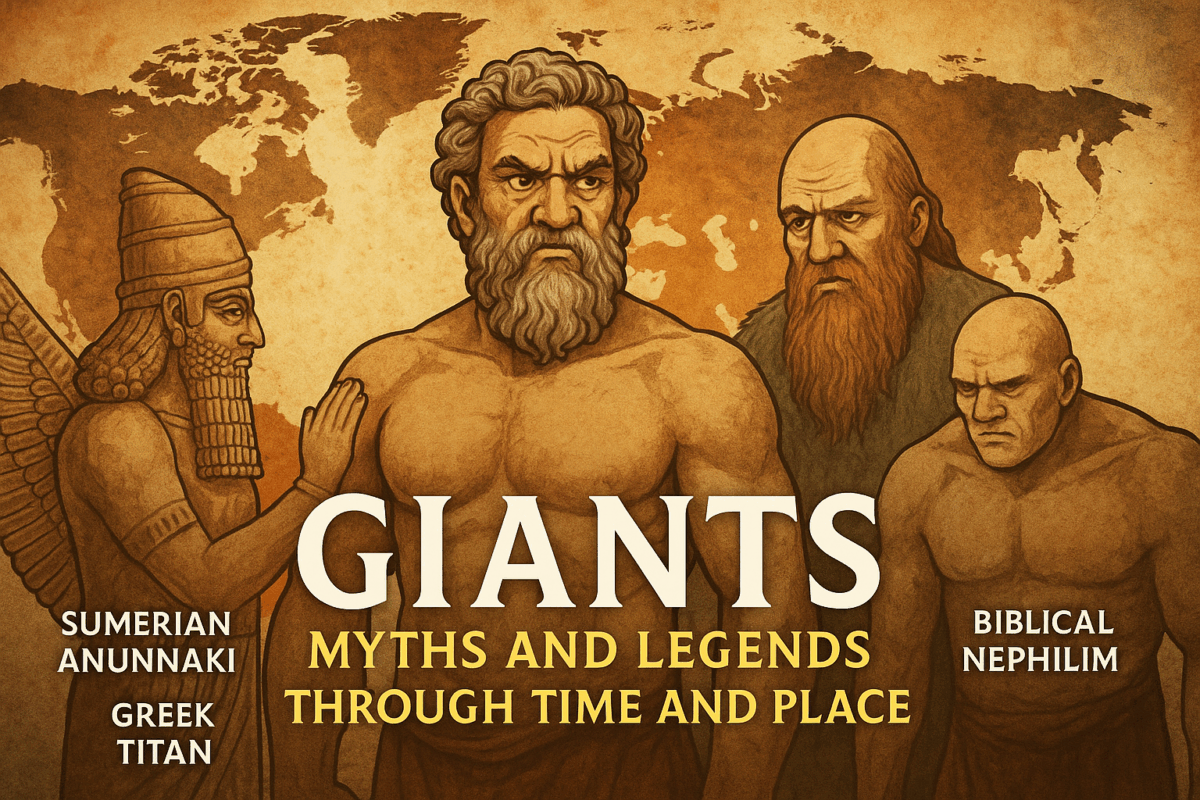
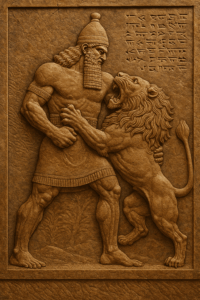
Did you know that virtually every ancient culture told stories of giants? From the oldest Sumerian carvings to the oral histories of Native Americans, legends of towering beings loom large. What’s truly fascinating is how these tales echo across time and distance – often in societies that had no known contact. Were these just imaginative myths, or could they hint at some hidden truths? 🤔
In this journey, we (Dave and Steve) are teaming up to explore giant lore around the world. I’m Dave “The Truth Seeker” Morrison – a bit gruff, tech-minded, and always skeptical of official narratives. And my friend here is Steve “The History Detective” Caldwell – a former history teacher with boundless enthusiasm for lost chapters of the past. Together, we’ll dig into five giant legends: the Sumerian Anunnaki, the Greek Titans, the Norse Jötnar, the Biblical Nephilim, and the Native American Si-Te-Cah. Along the way, we’ll banter and debate – blending my modern conspiratorial lens with Steve’s scholarly eye for detail.
So grab a seat (preferably on a large stone throne 😉) as we uncover the giants of myth and legend – where they came from, what they meant to their cultures, and why their stories refuse to die. Let’s get started!
Sumerians and the Anunnaki
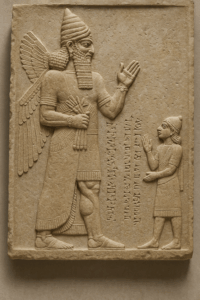
In the cradle of civilization – ancient Sumer (modern Iraq) – we find some of the earliest giant tales. The Sumerians spoke of the Anunnaki, a group of powerful deities often interpreted as giant beings who descended from the heavens en.wikipedia.orgen.wikipedia.org. In fact, the name Anunnaki can be translated as “offspring of An and Ki” – meaning the children of An (sky father) and Ki (earth mother) en.wikipedia.org. In other words, they were portrayed as princely offspring of Heaven and Earth, a concept strikingly similar to other cultures’ sky-earth unions (as we’ll see with Greek Titans). Sumerian creation myths, such as those recorded on cuneiform tablets, list the Anunnaki as divine figures who decreed the fates of humankind en.wikipedia.orgen.wikipedia.org. Mainstream historians view them as ordinary Mesopotamian gods – anthropomorphic and immortal, but not necessarily gigantic in physical form en.wikipedia.orgen.wikipedia.org. Notably, no Sumerian art explicitly shows a distinct race of giants called “Anunnaki”; the concept was more about rank and function in the pantheon than literal size en.wikipedia.orgen.wikipedia.org.
However, in the 20th century the Anunnaki took on a new larger-than-life identity. Certain fringe interpretations – most famously those of author Zecharia Sitchin – reimagined the Anunnaki as flesh-and-blood giant aliens who visited Earth in antiquity en.wikipedia.orgen.wikipedia.org. According to Sitchin’s books (e.g. The 12th Planet), these extraterrestrials came from a hidden planet called Nibiru and genetically engineered humans as a slave race to mine gold en.wikipedia.orgen.wikipedia.org. It’s a wild theory: picture ancient Mesopotamian carvings of bearded gods, and now imagine they were actually space-faring giants in bio-suits teaching humans agriculture and technology after a great flood en.wikipedia.orgen.wikipedia.org. Sitchin even claimed the Anunnaki might return at some point – he speculated by 2012, aligning with Mayan calendar lore en.wikipedia.org.
Steve: Did you know the mainstream view strongly rejects Sitchin’s ideas? Mesopotamian scholars point out that Sitchin’s translations of cuneiform are way off en.wikipedia.org. The Anunnaki in original texts are just gods – not alien engineers. There’s zero evidence in Sumerian records of Nibiru or genetic experiments en.wikipedia.org. Essentially, Sitchin took creative license and ran with it.
Dave: “Wake up, people!” Sure, academics dismiss it – but they often dismiss anything that smells of ancient astronauts. I remain skeptical of Sitchin’s specific claims (no offense, but he really bent the translations). Yet I’m intrigued by why so many cultures talk about sky-beings creating humans. Sumerians had Anu and Enki; other myths have sky-father gods too. It’s like a collective memory of something. Could be just the human tendency to look upward – or maybe there’s a buried truth in there. I keep an open mind, with a healthy dose of doubt.
What’s undeniable is that the Anunnaki myth has captured modern imaginations. Whether as literal giants or symbolic deities, these figures set the template: giants as bringers of civilization (or sometimes destruction) from a higher realm. The Sumerians, living 5,000+ years ago, likely intended the Anunnaki as metaphors for natural forces and divine authority en.wikipedia.orgen.wikipedia.org. But later generations – even up to today’s YouTube theorists – have transformed them into something more grandiose. As we leave Mesopotamia and head west to Greece, watch how this idea of elder sky-earth giants evolves in a new context.
Greek Titans
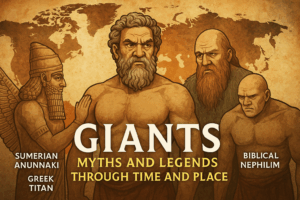
Across the Aegean Sea, the ancient Greeks wove their own tapestry of giant lore. Their primordial beings were the Titans – twelve mighty gods (six male, six female) born of Uranus (Sky) and Gaia (Earth) en.wikipedia.org. Right away, we see a parallel to Mesopotamia: sky father + earth mother = giant offspring. It’s almost the same formula as the Anunnaki’s parentage of An and Ki en.wikipedia.org, which fascinates comparative mythologists like Steve. The Titans – names like Cronus, Rhea, Hyperion, Theia – ruled during a legendary Golden Age. They weren’t just big in a physical sense (though art often depicted them as towering figures); they were cosmically powerful. Think of them as the first dynasty of gods, embodying elemental forces like ocean, sun, moon, memory, and so on en.wikipedia.orgen.wikipedia.org.
According to Hesiod’s Theogony, the Titans eventually fell in a massive war called the Titanomachy. Cronus, who had overthrown his own sky-father Uranus, was in turn defeated by his Olympian children (Zeus, Hera, Poseidon, etc.) en.wikipedia.orgen.wikipedia.org. The vanquished Titans were imprisoned deep in Tartarus – a sort of divine dungeon in the earth’s bowels en.wikipedia.org. This “succession myth” has a recurring theme we’ll spot in other cultures: an older race of giants clashes with a newer order of gods or humans and loses. It’s like an allegory of progress – old gods (or ancestors) yielding to new gods (or people). Yet the memory of the old giants never quite dies…
Steve: I love how the Titans personify natural phenomena. For example, Oceanus was literally the Ocean, Helios was the Sun (though technically a second-generation Titan) en.wikipedia.orgen.wikipedia.org. The Greeks were encoding a scientific worldview in myth – the big forces of nature were envisioned as these massive divine beings. And Dave, get this: the term Titan has become synonymous with greatness. Even today we say “titans of industry” or name rockets “Saturn V” (Saturn is Cronus’ Roman name). Their legacy is linguistic too.
Dave: True, the cultural impact is huge (pun intended). But I’m also drawn to how Greek myth hints at forbidden knowledge. Prometheus – sometimes called a Titan – defied Zeus to give humans fire, an echo of maybe some ancient intervention story. Some fringe theorists even equate Titans with Anunnaki or watchers. They point out, as you did, the sky-earth parentage coincidence. Could it be ancient storytellers in different lands were remembering the same thing? Giants who were half-divine, who taught mankind arts and sciences, and were punished for it. That pattern sure fits Prometheus, and we’ll see it with the Nephilim too.
Indeed, the Titans have often been compared to the biblical Nephilim by modern enthusiasts looking for common ground. While academic historians don’t endorse that directly, they do note the structural similarities among myths. The Greek Titans, importantly, were not depicted as monsters – that role was given to the separate race of Gigantes (born from Gaia and Uranus’ blood, leading to the Gigantomachy against the Olympians). So fun fact: the very word giant comes from Gigantes, but those were distinct from the Titans in myth en.wikipedia.orgreddit.com. Still, in everyday usage we often blur Titans and giants together as “huge old gods.”
From carved Greek temple friezes to baroque paintings like Cornelis van Haarlem’s Fall of the Titans, the image of gigantic figures toppled by younger gods is iconic. It symbolizes cosmic order overturning chaos. Yet the Titans live on in myths of the post-Titanomachy world: Atlas holds up the sky (a Titan’s punishment), Prometheus chains to a rock, etc. The Greeks, like the Sumerians, imagined a time before the familiar world – an age of giants whose downfall paved the way for humanity’s current order. Let’s now journey north, where the Norse had their own twist on this idea.
Norse Jötnar

In the frozen North, the Vikings and their Norse ancestors told tales of the Jötnar – often translated as giants, though the term literally means something closer to “devourers”sonsofvikings.com en.wikipedia.org. The Jötnar (singular Jötunn) are a race of beings in Norse mythology who stood in contrast to the gods (the Aesir and Vanir) en.wikipedia.org. Unlike the clear-cut Titans vs Olympians scenario, the relationship between Norse gods and giants is complicated. They are sometimes enemies, sometimes lovers, sometimes even kin. For example, Odin the All-Father is part-Jötunn by ancestry, and Thor regularly fights Jötnar (like the thunderous showdown with the frost giant Hrungnir). The Norse cosmos even begins with a primeval giant: Ymir, a hermaphroditic titan formed from ice and fire, whose body the gods eventually dismember to create the world reddit.comlifeinnorway.net.
One might imagine the Jötnar as huge, hulking brutes – and indeed many are described as enormous or shape-shifting. But interestingly, Norse sagas don’t always stress their size. Scholars caution that calling them “giants” is a bit misleading, since not all jötnar were necessarily enormous en.wikipedia.org. Some could appear human-sized or take on fair forms (several Norse gods marry giantesses, for instance). The word Jötunn likely derives from an older term for “glutton” or “man-eater,” emphasizing their wild, untamed nature rather than just stature sonsofvikings.comen.wikipedia.org. Essentially, they represent the chaotic forces of nature – the personification of mountains, frost, fire, the ocean, and the night that constantly threaten the orderly world of gods and men.
Steve: Here’s where it gets really interesting – the Norse myths preserve a balance between giants and gods. The Jötnar aren’t purely evil; they’re part of the natural order. Thor’s own mother was said to be a Jötunn. There’s even a prophecy that at Ragnarök (the end of the world), the giants will storm Asgard and many gods and giants alike will perish. It’s almost an apocalyptic last battle between giants and gods, reminiscent of the Titanomachy but set in the future.
Dave: And from a conspiratorial angle, I find it curious that nearly every culture has this war-of-the-gods narrative. Norse skalds describe two factions – one more human-friendly (Aesir gods) and one more primordial (Jötnar) – clashing repeatedly. If I slip on my speculative hat: could this reflect some ancient memory of different peoples or even species competing? Some have theorized about a lost race in prehistory… But I digress. What’s undeniable is the symbolism: giants embody the untamed wilderness that civilization (the gods) must wrangle with. Yet the Norse also acknowledged that you couldn’t have creation without the giant (literally, no world without Ymir’s body). It’s a love-hate cosmic relationship.
In colorful Norse art and later Scandinavian paintings, we often see Thor, hammer in hand, battling hordes of Jötnar amid lightning – a vivid metaphor for taming nature’s fury. One famous 1872 painting by Mårten Eskil Winge, Thor’s Fight with the Giants, shows the thunder god in a rage, mowing down giants with Mjolnir. The Jötnar may not be as widely known today as Greek Titans, but they left a mark in our pop culture (hello, Jotunheim in Marvel movies). More importantly, they underscore a theme: giants as forces of chaos and antiquity. This theme leaps out again when we turn to scripture and consider perhaps the most debated giants of all – those briefly mentioned in the Bible.
Biblical Nephilim
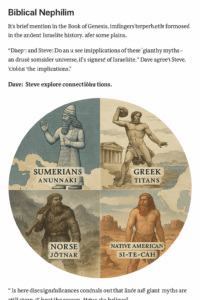
Of all giant legends, the Nephilim have fueled some of the most intense speculation. The Hebrew Bible (Old Testament) makes only a few brief references to these beings, yet that was enough to spark millennia of wonder. In Genesis 6:4 we read: “The Nephilim were on the earth in those days – and also afterward – when the sons of God went to the daughters of men and had children by them”. The text is scant on details, but traditionally Nephilim are understood as giants – an ancient race born from the union of heavenly beings (“sons of God”) and human women en.wikipedia.orgen.wikipedia.org. In fact, most ancient and medieval translations explicitly render Nephilim as “giants.” For example, the Greek Septuagint, the Latin Vulgate, and other early interpreters all used words meaning “giants” to describe the Nephilim en.wikipedia.org. The very term Nephilim has been linked to the Hebrew root n-f-l (“to fall”), often interpreted as “fallen ones” – possibly hinting at fallen angels or fallen heroes en.wikipedia.org.
So what were they? According to the apocryphal Book of Enoch, the Nephilim were the children of angelic Watchers who lusted after human women. These hybrid offspring grew into immense, violent giants that ravaged the earth and taught mankind forbidden arts, leading God to send the Flood as judgment en.wikipedia.orgjw.org. While Enoch isn’t part of the standard Bible, it elaborates the backstory: 200 Watcher angels rebelled, and their progeny (called gebbarim or giants) oppressed humanity. This narrative dovetails with other Near Eastern myths of divine beings interbreeding with humans – a bit like the mating of gods and mortals in Greek myth, but with a darker, catastrophic twist.
Steve: The Nephilim are a historian’s headache and delight all at once. Mainstream scholars caution that the Genesis passage is ambiguous. Some read the “sons of God” as just the godly line of Seth mixing with the worldly line of Cain (so Nephilim would then mean “fallen” aristocrats or warriors) en.wikipedia.org. But clearly the dominant historical view, even among ancient Jews and early Christians, was that these were angel-human hybrids. I mean, later parts of the Bible (like Numbers 13:33) mention the Anakim, said to be descendants of the Nephilim, described as huge – “we seemed like grasshoppers next to them,” said the Israelite spies. That implies literal great size. It’s as if remnants of a giant race lingered in Canaan.
Dave: And here’s where my ears perk up: If such giants ever existed, where’s the evidence? There have been numerous claims of giant skeletons found – from 19th-century newspaper reports to modern internet memes. The Smithsonian Institution often gets dragged into this, accused of hiding or destroying giant bones to protect conventional history. In fact, a viral story in 2014 claimed the Smithsonian had admitted to destroying thousands of giant skeletons. It turned out to be a hoax, thoroughly debunked vocal.media. But the very persistence of that conspiracy shows how the Nephilim idea grips us. Millions of people suspect there’s “fire behind the smoke,” believing that a literal race of giants might have walked among our ancestors vocal.media. I maintain healthy skepticism – extraordinary claims need extraordinary proof – but I can’t help being fascinated by the possibility. What if those old reports of 8 or 10-foot skeletons in American moundsvocal.mediavocal.media weren’t all fabrications?
From a faith standpoint, some see the Nephilim story as a cautionary tale about boundaries – heavenly beings weren’t supposed to mingle with earthly flesh. The resulting giants symbolize a gross violation of the natural order, bringing violence and corruption. Themes of divine knowledge corrupted, giants as tyrants, and cataclysm follow. It’s pretty much the plot of many a fantasy novel now! And thematically, it matches Greek and Sumerian arcs: divine/giant hybrids lead to civilization’s collapse (think flood). By the way, Steve, the word Nephilim pops up again subtly after the Flood, when the Israelites later encountered giant clans like the Anakim and Rephaim in Canaan. It’s as if echoes of that primeval giant era continued into later history, but dwindling.
So whether one reads it as folklore or fact, the Nephilim stand as a haunting symbol: the might of giants ultimately cut down by divine judgment (in this case, the Flood). The notion of an ancient race of giant heroes (or monsters) wiped out in antiquity clearly resonated across cultures. Speaking of lost giants, our final stop brings us to the legends of North America – where indigenous peoples have their own tales of formidable giants, including one particularly intriguing story from Nevada’s Lovelock Cave.
Native American Si-Te-Cah
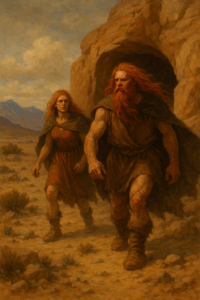
Traveling now to the deserts of Nevada, we find the legend of the Si-Te-Cah – a tale that shows giant lore is truly global. The Northern Paiute people have long spoken of red-haired, cannibalistic giants called the Si-Te-Cah (meaning “tule eaters”). According to oral history, these giants were hostile and human-eating, and the Paiute eventually united to wage war against them, exterminating the last of them in a pitched battle at a cave en.wikipedia.orgen.wikipedia.org. That cave is known today as Lovelock Cave. Here’s where myth meets archaeology in a tantalizing way: Lovelock Cave is a real site, rich in ancient artifacts. In 1911, guano miners (yes, mining bat poop!) stumbled on artifacts and bones there en.wikipedia.orgen.wikipedia.org. Later official excavations recovered over 10,000 relics – including eleven duck decoys made of tule reeds, remarkably preserved and about 2,000 years old en.wikipedia.orgen.wikipedia.org. These decoys are considered the oldest known in the worldblm.govblm.gov, and they match Paiute lore that the Si-Te-Cah used tule rafts on nearby Humboldt Lake (hence “tule-eaters”).
Now, did archaeologists find actual giant skeletons there? This is where facts and folklore diverge. The scientific reports note human remains, but they were of ordinary stature by average standards (the largest reported was around 6 feet tall – tall but not monstrous) en.wikipedia.orgen.wikipedia.org. However, early 20th-century local legends and some sensational press stories claimed “giant” mummies were found – some accounts say 8 or even 10 feet tall. These claims were never verified by credible science; many likely grew in retelling. Yet, the story refuses to die. Recently as 2024, news outlets revisited Lovelock Cave with headlines about “red-haired giants” after some archaeologists found 15-inch sandals and a handprint in a boulder during nearby cave explorations ndtv.comndtv.com. A 1931 newspaper article indeed had reported two huge skeletons (8½ and 10 feet tall) found in a dry lake bed near Lovelock ndtv.comndtv.com. Those remains, if they existed, have since vanished or were never documented in institutional collections.
Steve: The Si-Te-Cah narrative is a fantastic example of indigenous mythology intersecting with colonial-era “giant craze.” Paiute author Sarah Winnemucca, in her 1883 memoir, wrote about a small band of barbaric red-haired people her ancestors fought – she didn’t explicitly call them giants, but later tellings exaggerated their height en.wikipedia.orgen.wikipedia.org. It’s important we respect that this is Paiute history from their perspective. They even kept a lock of reddish hair and a dress trimmed with it as heirlooms, according to Winnemucca en.wikipedia.org. So something definitely happened – perhaps a conflict with a rival group who were physically distinct (maybe a different tribe or odd settlers). Over generations, memory can turn formidable foes into literal giants.
Dave: Absolutely, and I acknowledge that colonial miners and journalists have a history of sensationalizing native stories. But I have to say – when I first heard about Lovelock Cave, my conspiracy senses tingled. Here we have a cave where legend says giants were killed, and in real life it coughs up ancient unusual artifacts. The fact that red hair was mentioned is intriguing: some of the naturally mummified remains did have reddish hair, likely due to mineral staining over time (it’s a known phenomenon) ndtv.comndtv.com. Some giant-chasers claim that’s proof of a non-native, perhaps even Atlantean people (red hair is rarer among indigenous Americans). It’s a leap, but it shows how physical details get woven into the lore. While mainstream scientists haven’t confirmed any enormous skeletons, they have confirmed one thing: there was violent conflict at the cave. Archaeologists found a layer of charcoal and burned arrow shafts near the cave entrance, consistent with the tale of the giants being smoked out and burned alive inside ndtv.comndtv.com. That sends chills – it aligns with the exact ending of the Paiute war story.
In any case, the Si-Te-Cah legend reinforces classic motifs: giants as dangerous outsiders, eventually destroyed by heroes of “normal” size. And intriguingly, it sits alongside dozens of other native giant lore – from the Algonquian Wihtikow cannibal giants to the Iroquois stories of Stone Coat giants. Even across the Great Basin, other caves yielded supposed “giant” remains (like an 8’4″ skeleton claimed at Spirit Cave, though modern reanalysis identified those bones as a man about 5’10”). Clearly, giants stalked the imaginations of peoples around the world, not just the Old World. And whether those imaginations were inspired by real encounters (with say, extremely tall individuals or distant memories of megafauna bones) or purely symbolic fears, the narratives show remarkable consistency.
Threads of Truth and Wonder
Stepping back, what do all these giant tales have in common? Despite arising in different eras and cultures, we can spot some shared themes:
- Divine-Human Hybrids: Many giants are born from the union of gods or otherworldly beings with mortals – from the Nephilim (angel-human)en.wikipedia.org to the demigod Titans (sky-earth)en.wikipedia.org. Giants often literally embody the mixing of heaven and earth. This echoes an ancient idea: extraordinary size and power must come from a bloodline beyond the ordinary.
- Forbidden Knowledge & Hubris: Giants frequently are cast as teachers or violators of cosmic law. Prometheus (a Titan) gives fire to man, defying Zeus. The Nephilim Watchers teach weaponry and enchantments, defying God. Even the Si-Te-Cah, in Paiute telling, broke the natural order by practicing cannibalism. In many cases, giants symbolize hubris – reaching beyond bounds – and their downfall serves as a caution.
- Conflict with the “Gods” or Heroes: Almost every giant race faces war with gods or humans. The Olympians overthrow Titans en.wikipedia.org, the Aesir battle Jötnar at Ragnarök, David slays Goliath (a giant warrior), the Paiutes exterminate the Si-Te-Cah en.wikipedia.orgen.wikipedia.org. The giant vs. hero trope illustrates that might alone doesn’t guarantee victory; often it’s cunning, virtue or divine will that brings giants down. This could reflect an early human hope that brains can trump brawn – reassuring if you’re a 5-foot villager in a world of towering challenges.
- Ancient Past & Lost Worlds: Giants are almost always relegated to “long ago.” They belong to a prior epoch – the Golden Age, the time before the Flood, “many generations ago,” etc. This lends a misty credibility (“well, maybe there were giants back then, who knows?”) and also a wistful tone. Many myths imply the world was more extreme and magical in its youth – literally larger-than-life. The end of giants often marks a transition to the world as we know it.
- Judgment and Cataclysm: Frequently, giants’ extinction is tied to a cataclysm – the Flood for Nephilim en.wikipedia.org, the Titanomachy and subsequent deluge in Greek myth (Deucalion’s flood), or simply a great war. It’s as if the removal of giants was necessary for humanity to thrive. They are cast as both cause and victim of great disasters.
What should we make of all this? On one hand, you could say giants are a recurring symbol – representing human fears (of the powerful, the other, nature’s wrath) and aspirations (the desire for strength and connection to the divine). There may also be a kernel of truth in some cases: prehistoric encounters with very tall tribal people, or discovery of gigantic animal bones (like mammoth fossils) misinterpreted as humanoid. Science hasn’t found skeletal evidence of a past race of giant humans – beyond the range of known human variation – despite what conspiracists claim. Yet, the cultural evidence is undeniable: our ancestors needed giants in their stories.
In a world without modern science, giants answered pressing questions. Why are there mountains and great floods? Giants. Who built the ancient mounds or megaliths that our current people couldn’t? Giants. Why does evil or hubris get punished? Giant villains to smite. Giants were the larger characters that made the plot of world history more thrilling and morally clear.
And perhaps, on a subconscious level, they reminded people of the potential within and above us. As descendants of the Anunnaki or Nephilim, maybe we’re capable of more than we think – but the caution is there too: don’t reach too high, or you’ll share the giants’ fate. ⚡️
In the end, whether you approach giants as metaphor, memory, or mystery, they stand tall in the human imagination. From Sumerian seals to Norse sagas to desert caves, they refuse to be forgotten. Why do these legends persist? Steve might say it’s because the lessons they carry are timeless. I might add that there’s an undying what if that tickles our curiosity. After all, who wouldn’t be awed by the thought that perhaps somewhere, sometime, giants really walked the earth?
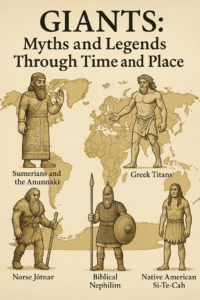
Curious to know more? The journey doesn’t end here. Below you’ll find a reading list of intriguing books and resources – plus some tools and curiosities – to help you explore the truth (and tall tales) of giants yourself. Until next time, keep seeking, keep questioning, and remember: the truth is out there, even if sometimes it’s hiding right under our feet (or under a few tons of guano in a cave)! 🕵️♂️🗺️
📚 Suggested Reading List
Books:
- The Twelfth Planet – Zecharia Sitchin (Earth Chronicles #1). An infamous take on Sumerian myths and alien “giants”. 【Amazon UK】【The Twelfth Planet – Book I of the Earth Chronicles (Zecharia Sitchin)】
- Giants on Record: America’s Hidden History – Jim Vieira & Hugh Newman. A deep dive into reported giant skeleton discoveries and the debate around them. 【Amazon UK】【Giants on Record: America’s Hidden History, Secrets in the Mounds and the Smithsonian Files】
- The Book of Enoch (Complete Collection). An ancient text exploring the fallen Watchers and their giant offspring – essential for understanding Nephilim lore. 【Amazon UK】【The Books of Enoch: Complete Collection (Illustrated Edition)】
Tools for Truth-Seekers:
- Marshalltown Archaeologist’s Trowel. A high-carbon steel pointing trowel – just like real field archaeologists use to unearth the past. Sturdy enough for your own “giant” dig. 【Amazon UK】【Marshalltown Archaeology Pointing Trowel (Wood Handle)】
- Ledlenser UV Handlamp. This 1000-lumen headlamp includes a UV mode – great for examining petroglyphs or hidden cave markings at night (who knows what giant clues glow under UV?). 【Amazon UK】【Ledlenser H7R Core Rechargeable Head Torch – 1000 Lumen】
- Garrett ACE 300i Metal Detector. A quality detector to scan burial mounds or cave floors. If there’s an ancient giant’s axe or a cache of “forbidden” artifacts, this might find it. 【Amazon UK】【Garrett ACE 300i Metal Detector (Special Edition)】
Curiosities & Collectibles:
- Mythical Monster World Map (Poster). An illustrated world map charting legendary creatures (yes, including giants) across different countries. A beautiful way to visualize the global spread of mythic giants. 【Amazon UK】【Mythical Monster Map – Legendary Creatures of the World (Poster)】
- 7.9-Foot Giant Skeleton (Posable Prop). For a fun take on giant lore, this huge Halloween skeleton lets you create your own giant “remains” exhibit in the backyard. Stands 240cm tall! 【Amazon UK】【7.9Ft Life-Size Giant Skeleton – Halloween Decoration】
- Atlas Titan Figurine (Bronze Finish). A desk-sized statue (about 9.5″ tall) of Atlas bearing the heavens on his shoulders. A classy nod to the Greek Titan who held up the sky – and a great conversation piece. 【Amazon UK】【Veronese Design – Atlas Carrying the World Bronze Mini Statue】
Affiliate Disclosure: As an Amazon Associate, UncoveredTruths earns from qualifying purchases. We’ve curated these recommendations to complement the topics discussed – if you choose to buy via our links, it helps support our research (at no extra cost to you). Thank you and happy exploring!
